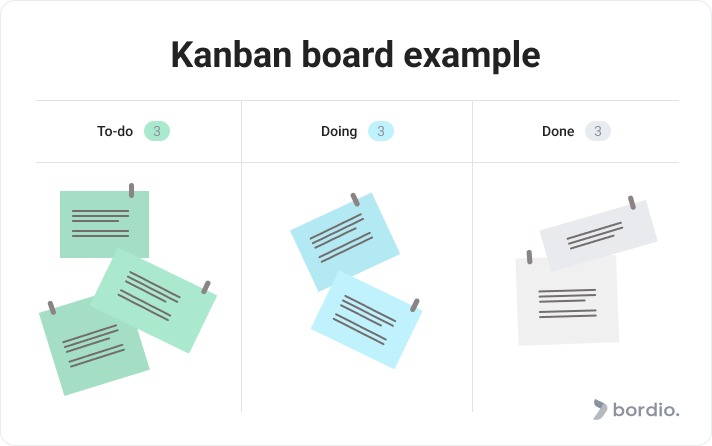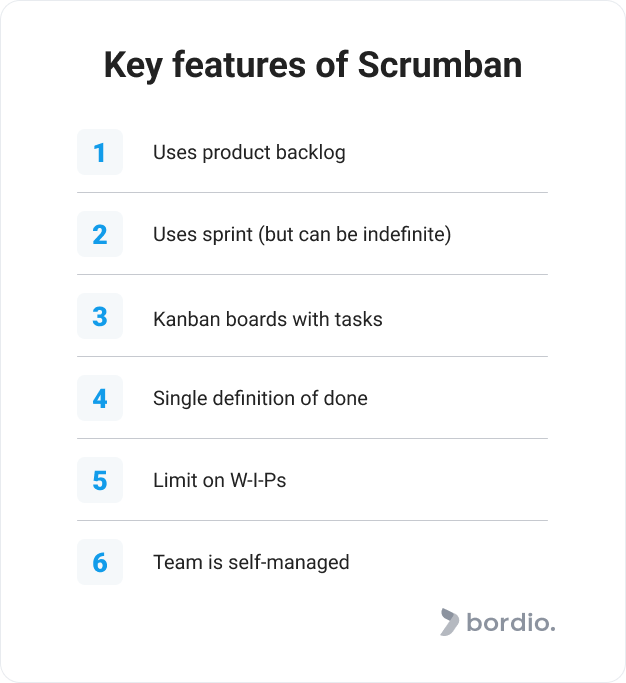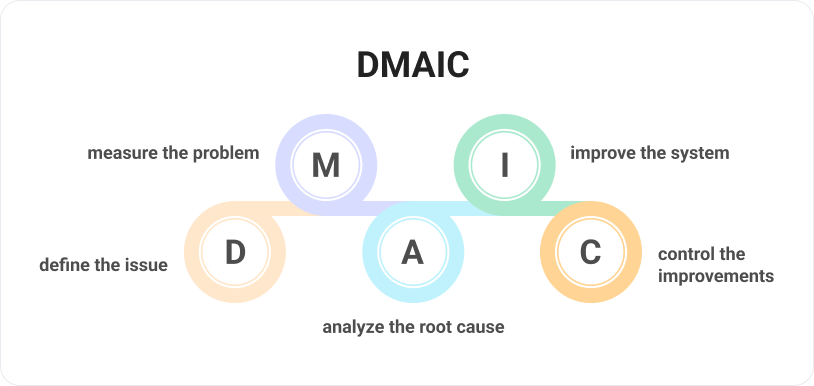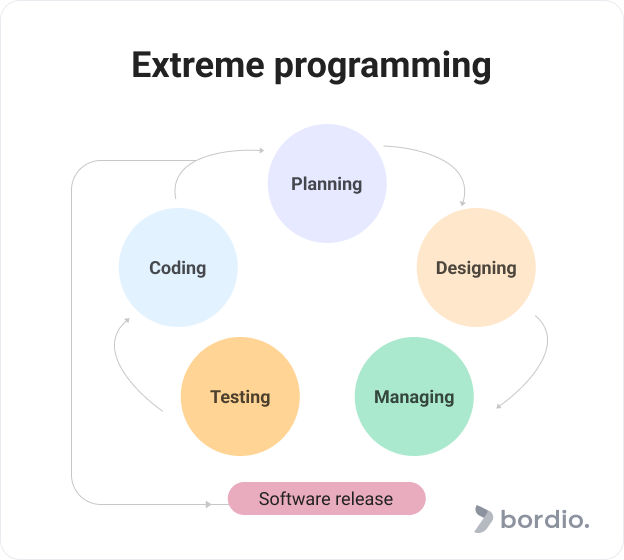Project management brings many benefits to the endeavors that a company or an individual might plan.
It helps us keep our working process organized and efficient, improve teamwork and collaboration, and, ultimately, get to our goals faster with better results.
To get those benefits, the science of project management offers us a wide selection of methodologies that we can implement in order to get to our final destination. Some of those methodologies are complex, others are very conservative, and then there are methodologies that give us the freedom to mix and match different advice and instruments to make it work in our unique scenarios.
At Bordio’s blog, we’ve already talked plenty about the importance of project management, the top skills that one needs to become a project manager (PM), and different tools like the risk assessment matrix.
In this article, we will share a digest of the project management methodologies that are important to be aware of in 2025 and onwards. We’ve tried to include absolute favorites but also lesser-known yet important frameworks that can help your projects get better and stronger.
Project management methodologies
As in any dynamic field, there are countless project management trends that people come up with. However, most of the time those new trends in project management are based on classic methodologies.
That’s why we are going to look into the tried and tested methods of project management that have helped thousands of project managers lead their projects to success.
Agile
The first one we will look at is the Agile methodology.
The agile approach to project management can seem relaxed or lazy to an untrained eye because it relies heavily on collaboration, the value of individuals over processes, and continuous improvement through frequent iterations. Agile project management is all about efficiency but in a healthy way that is sustainable for the team. Change is welcome as it helps the team evolve and projects get better.
Agile has 4 main values and 12 principles that we cover in detail in our Agile guide.
Agile has traditionally been praised and lowed by the technology world where there is no strict hierarchy and the management style is laid back in general. However, any organization can go Agile if they are ready to change their mindset and open up to the methodology’s principles.
Scrum
Scrum is a project management methodology that is mostly used by IT developers as it enables fast-paced innovation and value delivery.
In Scrum, there are 4 main roles: product owner, development team, Scrum Master, and stakeholders. The product owner is responsible for general project management but they are not leading the development team in the traditional way that we see other project managers. With Scrum, the team gets a lot of say in what will or will not be done in a project. They are also often in control of their daily planners and get to pick which tasks they want to do and work on them independently.
The Scrum project management process is divided into sprints. Each sprint is like a mini-project on its own with a defined set of goals and all the typical steps that a project consists of. There are 5 core meetings that are held each sprint which are called Scrum ceremonies, each following a different goal and helping the project thrive.
Scrum is often used in combination with Agile because of their common philosophy, as Scrum adds an actionable framework to Agile principles and values.
Kanban
Kanban is an approach to project management that relies heavily on visual systems and project management tools.
The key Kanban tool that made it famous worldwide is the Kanban board which shows both the total project workload and the progress with the tasks in the daily work tracker.
Kanban board consists of several columns that each represent a task completion stage. The minimum that every project needs are:
- To-do
- Work-in-progress
- Done.
All project tasks are written on cards and are initially placed in the to-do column in modern online planner.
Kanban is very democratic, so all team members can pick and choose the tasks they want to add to their individual to-do lists. In general, Kanban doesn’t place any limits or pose strict rules on the project teams with the only exception: there must be a limit on the number of cards in the work-in-progress column. It is done to ensure that the work actually gets done quicker and tasks are not being started and not finished. It helps the project move faster and the end product to be released to customers sooner.
Pro tip: use project management software that has Kanban board as a feature for maximum convenience. For example it is online time planner and online task organizer by Bordio. Mix it up with the physical Kanban board for gamification (if you work on-site too).
Scrumban
Scrumban, you guessed it, is a combination of Scrum and Kanban. There are many variations to Kanban, Scrum, and Agile but Scrumban has gained momentum and stood out among current project management trends.
Scrumban is a hybrid project management framework that has incorporated the best of the two approaches, and it adopts the main principles of Agile methodology. It is best suited for teams who have already had experience with Scrum and Kanban before.
Here are the main features of Scrumban:
- Uses a product backlog for tasks that must be completed.
- Works through sprints and utilizes Scrum ceremonies. However, there is not always a deadline for the projects, so teams can essentially work on it forever if the project is very long-term.
- Kanban boards are also used and tasks are applied to the board and moved along as cards.
- The team shares a single definition of done, making it easier to understand what it means to complete the task. It is important because team members often work independently and don’t necessarily report to anyone or get approvals before moving on.
- There is a strict limit on how many tasks can be in progress simultaneously. That helps the team keep a sustainable pace but also finish tasks faster.
- The team is self-managed: everyone is making decisions and sharing responsibility.
Waterfall
The Waterfall project management methodology is different from the ones we talked about up until now.
Waterfall is a very formal framework that uses a strictly linear approach to projects. And the name Waterfall symbolizes the process flow that takes you from one project stage to another as a series of waterfalls.
The framework is absolutely brilliant for projects where there is little uncertainty, processes are repeated over and over again, and change is unlikely. Project managers follow detailed guidelines which limit creativity but allow for advanced quality management and timeframes prediction.
An example that we like to use is construction: there are standards and regulations that determine the process of building a house. You are unlikely to change things up and build a roof before you do the walls, so Waterfall is a great fit.
PRINCE2
PRINCE2 is another formal framework that’s been overshadowed by new project management trends (such as Scrum and Scrumban), but it is nonetheless used by many teams across the world.
PRINCE2 translates as PRojects IN Controlled Environments. This project management methodology originated from the UK government sector, so as you can imagine, it is a very obedient and rule-following framework that is not a big fan of changes and experiments.
A fun fact about PRINCE2 though is that it counts most of its rules, principles, and standards in the number seven. There are:
- 7 key principles that must be followed
- 7 main processes (a.k.a. project stages)
- 7 well-defined roles with clear responsibilities
- 7 themes (each reflecting a different aspect of the project)
And then, shockingly, there are only six types of documentation. Don’t get us wrong six documentation types are A LOT, but our inner perfectionist would love them to add one more to make it seven!
Lean
The Lean framework has come a long way. It was first introduced to the Toyota factory to help update production and make it more efficient and less wasteful. As time passed, Lean made its way outside of the manufacturing world and into other areas of business, including the IT sector. Speaking of business It is also important to mention that we advise you to use the help of saas marketing agencies that will make your work easier by taking over part of the marketing task.
Lean popularized the project management trend of doing just enough and not wasting resources, be it human resources, time, equipment, or anything else. In fact, Lean defines 7 types of waste which we all outline in our Lean Startup guide. We recommend you check out if you’re interested in the methodology and try it while using online weekly schedule planner or other simple weekly schedule maker.
Speaking of Lean Startup, it is a highly popular deviation from the original Lean introduced by Eric Ries in his book on the subject. The key idea of the book is that startups need to move fast. They have no time to waste on excessive features and tests but instead should roll out an MVP (which he also categorizes in many different types) asap, test it with clients, implement changes, and then roll it out again. This whole process is called the Build-Measure-Learn loop.
Another interesting aspect of Lean startups is pivoting. Ries argues that pivoting is not a negative concept and promotes more startups to deviate from the original plan if they see that it’s not working out. A very helpful mindset for established businesses too, not only for startups.
Six Sigma
Next up is Six Sigma. We’ve put it in the project management methodologies list but some might argue that it’s more of a philosophy. We think it’s both.
Six Sigma is data-driven and its key focus is on quality which is continuously improved through an ongoing defect elimination.
Six Sigma follows an algorithm:
- It finds the defect.
- Determines the cause.
- Improves the process.
It works on delivering near-perfect products and services by transforming the business operations. Such ambitious goal can be achieved through multiple tools, the most famous one when it comes to Six Sigma being the DMAIC method which stands for:
- Define: the issue from a customer perspective, the goal, and the process.
- Measure: measure the problem (through data analytics) and estimate how end results will be measured too.
- Analyze: do the root cause analysis. What is causing the problem?
- Improve: Fix the issues that you’ve identified in the analysis.
- Control: Make sure the improved process is sustainable for the future.
Six Sigma is often combined with Lean as their key mission is quite similar – they both focus on elimination, whether it’s waste or defects.
Extreme programming (XP)
When you see the word ‘extreme’ in the name, you know it’s something fast-paced and intense. And indeed, Extreme programming, or XP, is used for IT projects with really tight deadlines and lots to be done.
XP creates short development cycles with a lot of releases. Kind of like Scrum but on steroids. Such an approach allows for maximum productivity and quick turnaround. It is great for quick and impressive results but should be used very carefully because nobody can work at a crazy pace without burning out at some point.
Extreme programming follows 5 main rules (a.k.a. stages):
Planning where the team confirms the project is viable and would fit the XP framework. It’s done largely by looking at the user stories, business values and priorities, and the stage of development that the team is in right now. You can do planning of teamwork in remote team software or in the work management systems by Bordio.
Managing where project managers seek to build a highly collaborative atmosphere through open spaces or common platforms with asynchronous work possibility. The key focus is on work progress, so tools like Daily Standup meetings are used to encourage and motivate one another.
Designing is for process design. The top used tool is a CRC card which stands for class-responsibility-collaboration and highlights how each task interacts with one another.
Coding where the team is writing the code that follows a list of strict rules to guarantee the best possible outcome in the shortest timeframe. The curious thing though is that XP values contact interaction with clients at the coding phase which means they get feedback and can implement it almost instantly.
Testing is performed multiple times throughout the programming process. Every piece of code has to be cross-checked. If any bugs are uncovered, additional tests have to be scheduled.
Critical path method (CPM)
The critical path method is a technique that defines what tasks are required for successful project completion. Project Management Institute identifies CPM as the longest sequence of scheduled tasks that define the timeframe of the project.
CPM helps us define what work is an absolute necessity for the project and what tasks can be pushed or given lower priority. As a result, the project team can plan better, allocate resources more effectively, and prevent any bottlenecks before they become a problem.
To define the critical path of the project, the team goes through a complete list of tasks, identifies dependencies, aligns the tasks with project goals, and prioritizes the deliverables.
Choosing the right project management methodology for you
With such a wide variety of methodologies, even experienced project managers might get a little lost.
When selecting the right path to manage projects, always look back at your previous experience and what the industry standard is but don’t let it dictate your route.
Here are a few factors to consider when choosing a methodology for your next project:
- The industry and the environment of the future project
- The project’s goals and objectives
- The complexity and importance of the project
- The cost, the budget, and the team size of the project
- The team’s and your own previous experience
- The key project stakeholders
The last point about stakeholders is often neglected which may lead to some issues.
That’s why it’s important to understand if they are flexible and chill enough to understand and appreciate Scrum? Or are they super conservative, so Waterfall or PRINCE2 will suit them much better? Stakeholders can make or break the project, so their potential take on your selected framework should not be underestimated.
Pro tip: Don’t be afraid to experiment. Project management is not rocket science where you must follow formulas and precise estimations. It’s perfectly fine to play with the frameworks and tools and adapt and adjust them into a hybrid methodology to fit your case. And remember about little helpers, such as advanced online calendar planners, such as Bordio’s schedule maker, that can help make experimenting and day-to-day management more seamless and fun.
However, remember that the methodologies follow their own logic and rules which lead to the best results. So as you are experimenting, don’t get carried away too much to damage the success of the project.
Final thoughts on project management methodologies
The project management industry has always been very dynamic, but the unpredictable uprise of remote work has made it even more prone to change and innovation.
We don’t know what the future project management trends will be but if you familiarize yourself with the methodologies we talked about today, then we guarantee that you will be confident in the project management landscape.
Project success is a fragile thing that depends on many factors, including the soft skills of new team members, how informed decisions are of the management, and weekly planning tools that are used.
But equally as important is the methodology that project managers choose to go with and how well they understand the principles and main rules of this project management methodology.
So don’t underestimate the importance of continuous learning and be open to whatever knowledge on the topic comes your way.








